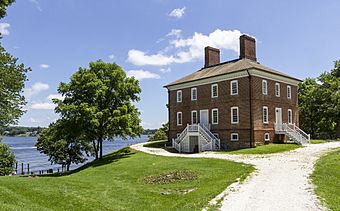London Town Publik House facts for kids
|
William Brown House
|
|

William Brown House, South and West Facades, July 2013
|
|
| Location | Historic London Town and Gardens, Woodland Beach, Maryland |
|---|---|
| Area | 1 acre (0.40 ha) |
| Built | 1745 |
| Architectural style | Georgian |
| NRHP reference No. | 70000262 |
Quick facts for kids Significant dates |
|
| Added to NRHP | April 15, 1970 |
| Designated NHL | April 15, 1970 |
The William Brown House is a very old building in Woodland Beach, Maryland. It's also known as the London Town Publik House. This historic building was once a busy tavern during the colonial period. It is part of the Historic London Town and Gardens museum complex in Anne Arundel County, Maryland.
The house was finished in 1764. It is a great example of a brick tavern from the colonial era. For many years, from 1828 to 1965, it was used as a place for people who needed help, called an alms house. Because of its important history, the William Brown House was named a National Historic Landmark in 1970.
Contents
What the William Brown House Looks Like
The William Brown House is located near the community of Woodland Beach. It sits on the south bank of the South River. This spot is about four miles from Annapolis. Today, Woodland Beach is also known as Londontowne.
The house is a two-story building made of brick. It has a raised basement. The roof is flat on top, like a deck, with a large chimney at each end. The windows on the front of the house have flat brick arches above them. Windows on the back and sides have rounded arches. The main entrance is in the middle of the front. It has a special roof design above it and is reached by brick and stone steps. A unique feature of this house is how the bricks are laid. All four sides use a special pattern called all-header-bond.
Inside, there is a wide hall that goes from the front to the back of the house. Smaller halls cross it in the middle. The back part of the main hall has a fireplace. This area was used as a living space. The front part of the hall contains the stairs. There are four rooms of the same size in the corners of the house. Each side of the house also has a door.
History of the William Brown House
William Brown built the William Brown House between 1758 and 1764. It was built on the main road that connected Williamsburg, Virginia and Philadelphia, Pennsylvania. At that time, people crossed the South River using a ferry. William Brown also owned this ferry.
The house was part of a small community with about 100 lots. The William Brown House is the only large building from that community that still stands today. Building such a grand house was very expensive for William Brown. He eventually owed a lot of money. Because of his debts, he had to give the house and property to the estate of James Dick. James Dick had lent Brown money for the house and lots.
In 1828, the county bought the house. They used it as a poorhouse, a place for people who were poor or sick to live. It served this purpose until 1965. Today, the William Brown House is a museum. The London Town Foundation operates it, sharing its history with visitors.
Other Interesting Places
- Upton Scott House in Annapolis, which was also built by William Brown and looks similar to this building.
- List of National Historic Landmarks in Maryland
- National Register of Historic Places listings in Anne Arundel County, Maryland
Gallery






